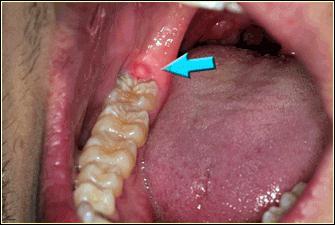An inconspicuous threat to the health of the tooth - cervical caries
Cervical caries begins, however, like everyone elseOther its types, from the stage of the spot. At this stage, a small spot appears in the gum area on the tooth. It can be distinguished by color. Usually it has a darker color than the color of tooth enamel. Over time, this spot will change color and become gray. The process of staining is due to the thinning of the surface layer of the tooth enamel and the appearance in it of microscopic pores that are filled with coloring substances, especially when using brightly colored food.
In the spotting stage, this caries is still reversible attimely detection and taking appropriate measures. It is most difficult to remove staining pigments from the stain. If the enamel surface in the caries area is dense and has a dark color, this may indicate a process of restoring enamel density. In this case, there is a compensated form of the disease. In this state, it can be for several months, and sometimes even for several years.
Cervical caries is often confused with anothera common dental disease, also located in this area of the tooth - a wedge-shaped defect. But they also have significant differences. If a defect in a wedge-shaped tooth breaks down for many years, then in our case the tooth can collapse in 6-12 months. The main difference between these diseases is the shape of the cavity. Cervical caries has an irregular shape. Its surface is friable and pigmented. The wedge-shaped defect was named after its shape in the form of a wedge. Its surface has a high density (similar to glass) and has almost no color.
In case of disease progression,the surface of the caries stain becomes loose again over time. The disease destroys the tooth, gradually penetrating into its soft tissues, such as dentin. At this point, the process becomes irreversible, because, unlike tooth enamel, dentin does not have the ability to recover. This tooth decay usually occurs after 30 years. It is characterized by the appearance of unpleasant sensations at the time of ingestion of food or drinks. At the same time, a painful pulsation is felt inside the tooth.
To notice the moment of transition from a stage of caries of enamelto the stage of dentin caries is not at all easy. This is due to the fact that the enamel in this area of the tooth is very thin. It is because of this that the damage to the dentin is extremely rapid. An important role is played by the individual stability of enamel, which in all people is different.
Cervical caries, treatment: it is assigned at the time of detection. Therefore, it is so important to visit the dental office regularly. If the dentin of the tooth is already involved in the process, urgent treatment is required. If no measures are taken in this case, tooth decay will continue and the cervical caries is transformed into the root. With a slight damage to the enamel, remineralizing drugs can be used.
When treating such caries use a localanesthesia, as the surface of the tooth, located near the gums, is extremely sensitive. With a more neglected disease, the enamel is thoroughly cleaned from the existing plaque. For this, a variety of cleaning methods are used: mechanical, laser, chemical, ultrasonic. The dentist removes the necrotic dentin and forms a carious cavity. After this, the tooth is restored immediately.
Existing prevention: Cervical caries, like any other, rarely occurs on teeth that are maintained in proper condition with the help of ordinary oral hygiene: thorough cleansing with good toothpastes twice a day, rinsing, eliminating tartar.
</ p>

